France seems to be a watch country where there is still something to discover. At least, I keep coming across French manufacturers of watch movements that are largely unknown and that I have never heard of before. Victor Anguenot from Villers-le-Lac in the Département Doubs is one of them. The town is located just a few kilometers from Le Locle, one of the most important centers of the Swiss watch industry.

The history of V. Anguenot
François Victor Anguenot was born on 27.03.1874 in Charquemont, only about 25 km from Villers-le-Lac. His father, François Anguenot (1845-1907) is said to have been one of the oldest manufacturers in Villers-le-Lac for Roskopf watches.

When exactly Anguenot founded his company is not entirely clear. The same source [1] speaks of 1892, but also shows an advertisement from 1943 indicating 1900 as the year of foundation:
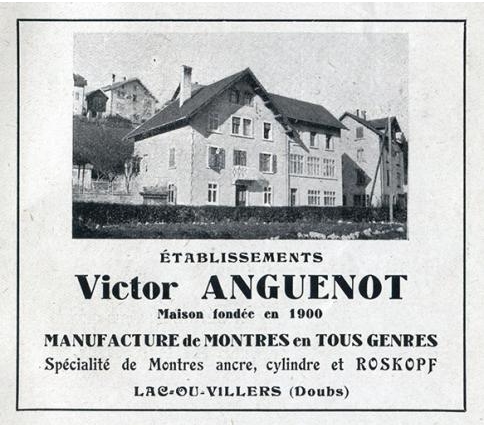
Victor joins forces with his brother-in-law Marcelin Joriot (1870-1956) in 1907 in a general partnership dedicated to the manufacture and sale of watches. This association continues later with Marcelin’s son André.
The company Victor Anguenot et Cie is specialized in flat watches according to the Roskopf construction. It sells watches to miners under its Régulateur Français brand (registered on January 12, 1922), but works mainly for wholesalers who apply their brand or that of their customers. And it also exports watches itself to Algeria and Tunisia.
Victor had a workshop and a garage built next to his house around 1925 and a new building in Rue de la Perrière around 1934, where he housed the production of the movements. The company had 46 employees in 1930, including 5 Swiss!
Victor Anguenot died in Villers-le-Lac on March 6, 1938, at the age of 63. In 1939, the company is transformed into a Sarl (limited liability company), with his son René Anguenot (1902-1988) and his son-in-law Jules Monnin (1902-1976) as its directors. The former took care of the manufacture of the movements, the latter of the finishing of watches and their marketing. The 19´´´calibers are abandoned in favor of only three calibers: the V. A. 37 with 16´´´, used for pocket watches, a flatter 16´´´ caliber, also for pocket watches, and the V. A. 24 caliber with 10 1/2´´´, developed by another of Victor’s sons-in-law, Freddy (Alfred) Boillot.
After the end of the war, the company had only a dozen employees. In the 1960s, it abandons the manufacture of its own movements and focuses on the production of wristwatches with lever escapement, using French and Swiss movements. Two new general managers are appointed when Anguenot and Monnin retire: Freddy Boillot and Jacques Monnin.
In 1975, the company reaches its zenith with 218,000 watches sold and 74 people employed. In the same year, the company again increases the production area and sets up a state-of-the-art production line. When Boillot retired, Jacques Monnin bought the business and founded Sarl Monnin-Anguenot with his wife Antoinette Boillon. Faced with competition, the business slowly went downhill until Jacques and Antoinette Monnin retired in 1994. At that time, the company employed only three people. It was then sold to the Cupillard-Rième company from Morteau.
By the way, besides V. Anguenot, there were other watch manufacturers named Anguenot in Villers-le-Lac, including Ulysse Anguenot (Curie brand), an uncle of Victor, and Anguenot Frères (Groupe Framelec, Herma brand), whose owner was one of Ulysse’s sons.
The watch movements of V. Anguenot
In various sources, I could find references to seven movements made by V. Anguenot:
| Caliber | Diameter | Features | Sources (1) |
| V. A. 24 | 10 1/2´´´ | Unknown, no proof of existence found so far | [1] |
| 16´´´ 22/12 Roskopf (2) = 16´´´ H4,1 Roskopf (3) | 16 1/2´´´ (4) | Pin lever, Roskopf construction, crown winding without pusher | [2],[3] |
| 16´´´ 27/12 Roskopf = 16´´´ H5,1 Roskopf = V. A. 37 | 16 1/2´´´ | Pin lever, Roskopf construction, crown winding without pusher | [1], [2], [3], [4] |
| 16´´´ 22/12 Ancre | 16 1/2´´´ | Swiss lever | [1], [3] |
| 18´´´ | 18´´´? | Unknown, only spare parts found so far | |
| 19”’ H5,6 Roskopf = 19.6 Roskopf | 19 1/2´´´ (4) | Pin lever, Roskopf construction, crown winding with pusher | [3], [4] |
| 19”’ H6,8 Roskopf = 19.7 Roskopf | 19 1/2´´´ (4) | Pin lever, Roskopf construction, crown winding with pusher | [3], [4] |
(1) See list of sources at the end of this article
(2) 22/12: Height in French Lignes (1´´´ = 2.2558 mm). 22/12´´´ correspond to 4.1 mm
(3) H4,1: Height in mm
(4) Although the caliber designation is 16´´´ or 19´´´, the movement has a diameter of 16 1/2´´´ or 19 1/2´´´ respectively
So far, I could only find movements by V. Anguenot in pocket watches of the brand Régulateur Français, which was registered by Anguenot in 1922. Now let’s take a look at two movements made by A. Anguenot.
Anguenot 19´´´ H5,6 Roskopf
The pocket watch shown may date from around 1930 – 40. Unfortunately, the second hand is missing. It has a simple chrome case with pressed bottom cover and has a diameter of 51.4 mm.
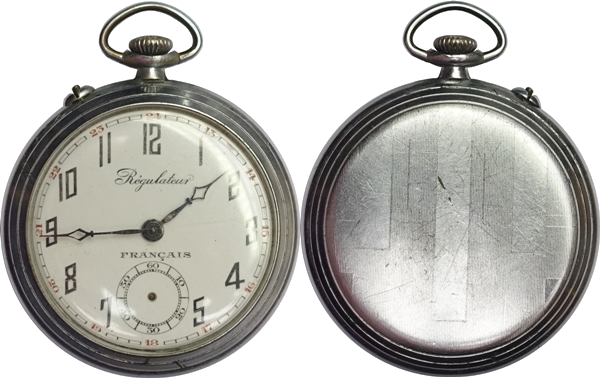
The movement, an Anguenot 19” H5,6, is also of simple construction. The brass balance initially suggests a cylinder escapement, but in fact, the movement has a pin lever escapement.
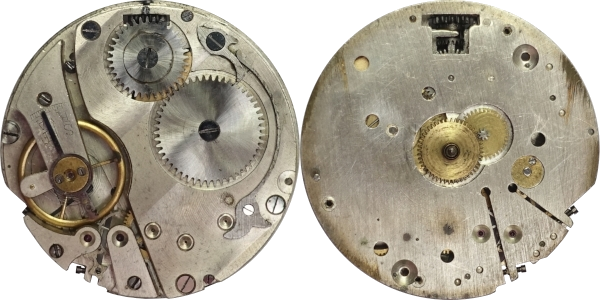
The movement has a crown winding mechanism. To set the time, you have to push a small pusher on the side. It uses the Roskopf construction, which means that the large mainspring barrel extends beyond the center of the movement, so that the minute wheel is missing in the center of the movement. The motion works is therefore directly driven by the mainspring barrel on the dial side. Typical for Roskopf movements is also the beat rate of the balance of 17,280 bph (beats per hour).
Only seven jewels and a pillar construction also confirm the impression of a simple, inexpensive movement.
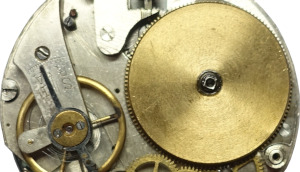
Interesting are the two screws in the right picture above at about 5 o’clock. They are used to adjust the engagement depths of the escapement (escape wheel, pallet, balance), i.e. to compensate for lack of precision in the manufacture of the components!
Anguenot 19´´´ H6,8 Roskopf
This movement is largely identical to the one just shown, but at 6.8 mm, it is a bit thicker and the dial side looks a bit different. It has no subsecond, but I assume that it was also available with second.
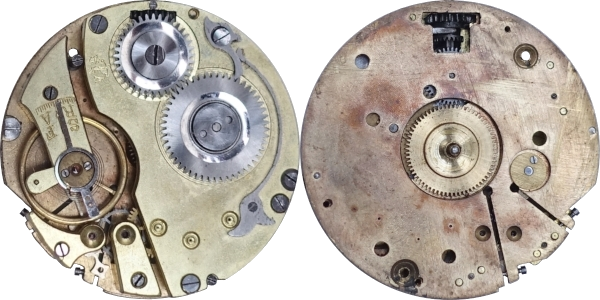
Anguenot 16´´´ H5,1 Roskopf / V. A. 37
The second pocket watch with a diameter of 48.4 mm also comes in a simple chrome case, but it has (once upon a time) luminous hands and numerals. Chronologically, it should be dated around 1940 – 50.
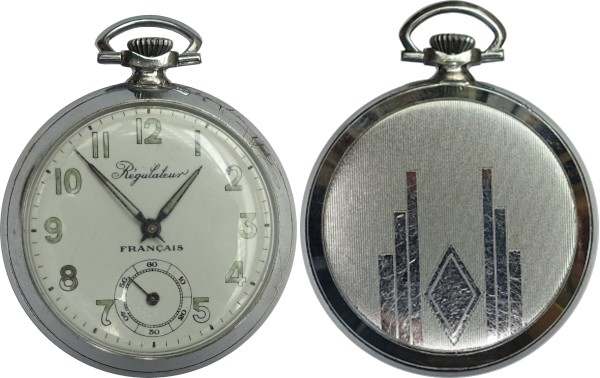
An interesting detail is hidden on the inside of the bottom cover, namely a more modern logo of V. Anguenot than the one shown above:

Somewhat more nicely rendered:

The movement, an Anguenot 16´´´ H5.1 Roskopf, also known as caliber V. A. 37, is visually only slightly different from the movement shown above. Of course, the movement with a diameter of 37.0 is significantly smaller than the one shown above with 44.2 mm.

The technical differences are also minor. The crown winding system with pusher was replaced by a contemporary crown winding system, where the crown is pulled to set the hands. Also, the two screws for adjusting the engagement depth of the escapement are missing, so the precision in manufacturing seems to have improved. Furthermore, the movement has nine jewels, one of which is the impulse pin of the balance, which is rather unusual for pin lever movements, since it usually consists of a metal pin on them.

This movement also seems to exist with a different click:
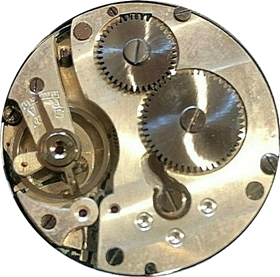
Anguenot 16´´´ 22/12 Ancre
So far, I could find only a picture of this movement in the Cétéhor catalog of 1946 [3]:
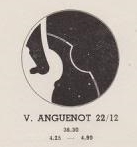
Since I can only show a few movements by Anguenot here, I would be very pleased if one of my readers could contribute another movement, which I would then be happy to include here. In particular, I would be interested to know if the movement V. A. 24 really exists!
Sources
[1] Usine d’horlogerie (usine de montres et d’ébauches de montre) Victor Anguenot et Cie ⋅ Patrimoine en Bourgogne-Franche-Comté (bourgognefranchecomte.fr)[2] Rudolf Flume: Flume-Kleinuhr-Schlüssel K1, 1958, in the part from 1947
[3] Cétéhor: Repertoire des Calibres de Montres Français, 1946
[4] Georg Jacob: Werk-Erkennung Gesamtausgabe, 1949
[5] Engelkemper: Der Engelkemper Werk-Spiegel Bildband, 1966
[6] François Victor ANGUENOT : généalogie par florineadb – Geneanet

Dear Sir,
I would like to thank you for the research and history you have produced regarding Victor Anguenot, I am a complete novice in Horology at the age of 88, I have taken an interest in the art from viewing on YouTube and just recently purchased a Regulateur Francais VA 37, from your picture I have already noticed that the hour/minute/second hands on my watch are not original,
My profession was Tool and Die, and Model Engineering as a hobby, I have a Taig lathe and Taig mill cncd and my mind is still good so I am excited to learn something new,
My wife Gisele is fluent German,
Walter Maisey,
holmes_ca_2000@yahoo.com
Alberta, Canada